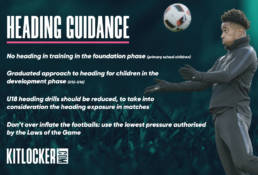If you haven’t already heard, the FA have released their updated guidance around heading the ball in children’s and youth football (up to U18s). The change comes following recommendations made by a University of Glasgow study into the potential links between heading footballs and the risk of developing brain disorders in later life.
How will this affect your football team? 🤔
It’s important to note that the new guidance only applies to training sessions, not matches, and is not yet being introduced in Wales. From ages U7 through to U11 there will be no heading in training whatsoever. Then from U12s upwards, heading should be gradually introduced to training sessions with slightly increased exposure year on year, all the way up to U18s.
The new policy seems to be widely supported in general, however some have raised the issue that U7s-U11s will be heading footballs in matches without ever having been taught the proper techniques around that particular skill. On the other hand of that argument, the amount of aerial play at that age is minimal and will probably be reduced even further now that children will be 100% focused on playing with their feet in training.

How has this come about? 🔬
The issue of heading in football and it’s possible links to dementia and other neuro-degenerative diseases has been a hot topic for a number of years. Dawn Astle has spearheaded the campaign to make the game safer since the death of her father, the former England and West Brom striker Jeff Astle, in 2002 at the age of just 59. Dawn is the founder of the Jeff Astle Foundation.
Astle’s death was the result of a degenerative brain disease, which the coroner concluded was caused by ‘repeated minor traumas’. One of Astle’s main attributes was his heading ability, in an era when heavy leather balls were used and long ball football was king. A verdict of ‘death by industrial injury’ was recorded.
The FA’s new guidance was welcomed by Dawn Astle, declaring it “a really sensible way to make the game we all love safer. There’s a lot more to do but it’s a great start and a real step in the right direction”.
Following the hard work of The Astle Foundation and the findings of a FIELD study carried out by the University of Glasgow, a taskforce was set up to devise the now publicised changes to The FA’s heading guidelines. To find out more about the study’s findings click here.

Less Heading, More Football ⚽
Aside from the long term benefits, many hope that other positive byproducts will emerge from the new guidance. In theory, youngsters will now spend more time with the ball at their feet rather than watching it fly around above their heads. It is hoped that this will result in more technically proficient young footballers coming through the ranks. Several other nations across the world (including most notably The Netherlands) already discourage heading in small sided youth football games, in favour of developing touch and technique.
But will this see the end of aerially dominant defenders like Van Dijk and Maguire, or target men like Olivier Giroud and Romelu Lukaku? Surely if our youngsters are not being trained on the ancient art of winning headers, the game as we know it will inevitably change. The sport will be even more focused on keeping the ball on the deck, with technically gifted players coming to the fore. Most would welcome this development, however there has always been something incredibly satisfying about seeing a striker leap like a salmon and tower above his marker to boom a header into the top corner. Could this soon be a thing of the past?
The truth is, the more that the links between heading and brain disease are highlighted, the more immaterial any arguments against gradually withdrawing it from the game become. And if cases like Jeff Astle’s can be eradicated then it should be welcomed with open arms.

What do you think? 🗣
How useful was this post?
Average rating 5 / 5. Vote count: 1
No votes so far! Be the first to rate this post.
